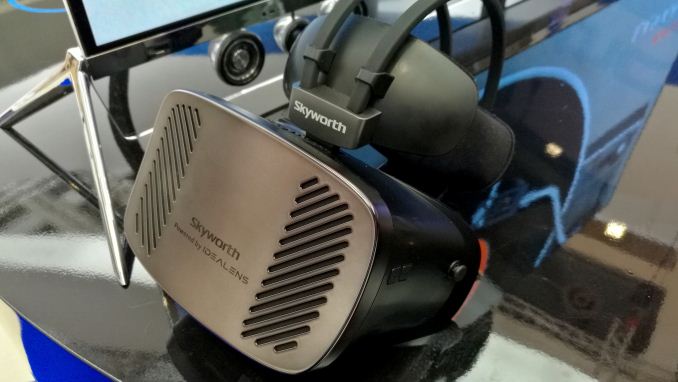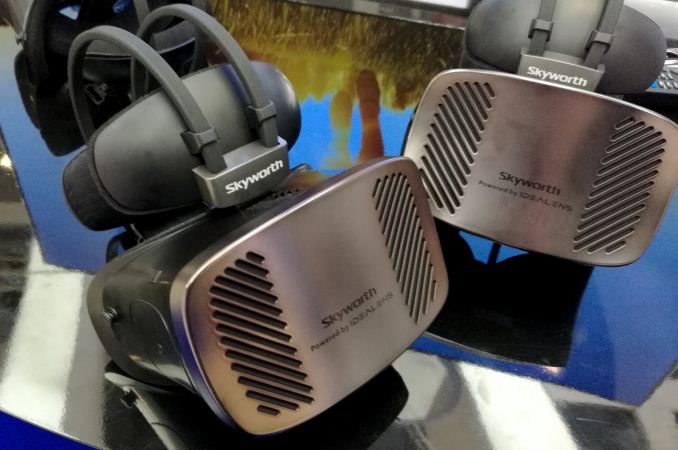IFA 2016: Examining the Malaise of Bargain Basement Virtual Reality
by Dr. Ian Cutress on September 9, 2016 9:00 AM ESTGoing Above $100: The Skyworth AIO-VR
In the last few minutes of the show I was steered towards the Skyworth booth in a different hall and told to go see their all-in-one headset. I was told that in comparison to the others, the Skyworth offering might be a substantial substitute above the cheap VR on display. The problem is always the cost, which we’ll get onto in a minute. The Skyworth VR setup was on display to test, however there were no specifications on display, and we weren’t allowed to take a picture of the image on the demonstrator’s phone that had all the hardware listed, but I was able to memorize a few key points.
It’s worth saying that the Skyworth AIO-VR was slightly bulkier than the other headsets, if only because the mechanism to mount it on your head was a plastic part of the design, aimed at balancing the weight a little but also securing it more firmly with padded guards. The outside was still plastic, however with a brushed metal look, and slightly more attention to detail.
The units were up and powered, and after putting it on I could tell the interface was smooth. Don’t get me wrong, the pixels were still quite obvious, but moving my head showed a high frame rate display better than the 30/60 Hz offerings of the cheaper implementations.
As far as I could jot down in a reasonable time, the headset uses an Exynos 7420, which is a 4x4 big.Little design using quad ARM Cortex A57 at 2.1 GHz and quad ARM Cortex A53 cores at 1.5 GHz on a 14nm process. The 7420 also uses Mali-T760MP8 graphics, at 772 MHz, which is good for 210 GFLOPs, and is paired with dual-channel (2x32-bit) LPDDR4. This SoC was powering dual 1080x1200 displays inside, which is a formidable number of pixels, and I saw that we’re looking at a 3800 mAh battery. Other specifications I can’t remember, though one would assume a 4GB/64GB arrangement for memory and storage if this was a smartphone.
So here’s the thing: the Skyworth headset is essentially a smartphone under the hood that you can’t take out. So what makes it better than a Samsung VR headset where the smartphone can be attached / detatched? One would assume it’s a price thing, and we were told the price for the headset could be $400 to $800. I remarked that it was a pretty large range, but was told that the Skyworth headset is still a work in progress, with exact specifications to be decided later. If it was $400, it might be more palatable, but for $800 then it might be easier to go the smartphone route.
The Problem with Low Cost VR
This brings us around to the problem with VR right now. Everyone wants in on the bandwagon, and in a keynote at the event it was pointed out that in order for triple-A style games and film studios to start making content in these new formats, there needs to be more potential sales out there. Current estimates put 500k headsets in the market (of varying degrees of power) with another 2.7 million by the end of 2017. No game studio or film studio, working on the next FPS or Avatar, will make a massive piece of content for only 3.2 million people – it needs to be in the hands of tens of millions to even start to make sense, and we won’t be at that point for a number of years.
All that being said, you have a choice – investing in a premium VR headset to be able to experience the best will cost $700+, in terms of the headset itself plus any extra hardware you need to power it. The easiest way to enter the VR space with some clout is the smartphone or all-in-one route, but that is still a hefty cost. Then there is a large, long gap to the segment of very basic all-in-one virtual reality headsets as shown at IFA this year.
For $100, or the rough price of the Samsung headset without any internal hardware, you get a basic quad-core Rockchip design with limited functionality. I’m half inclined to suggest that a bucket be provided as well, just in case nausea takes over. But it shows what a state VR is in, when the hardware is still so expensive. In order to get a base experience that can truly be called VR, such as with the Skyworth headset, it might be as much as a high-end smartphone anyway. For mass market adoption, the cost to enter has to be low, but not so low we’re scraping the barrel for basic frame rates.
Picture Galleries















































59 Comments
View All Comments
cocochanel - Saturday, September 10, 2016 - link
You could get a decent PC capable of VR for under a $1000. Say, a Zen + RX480 + 8Gigs RAM + SSD. Throw in an Oculus Rift for $600 and you're looking at around $1500. Where do you guys came up with the $3000 figure ? I suspect is the Nvidia camp who still insist that VR should start with a GTX 1080. C'mon.Death666Angel - Saturday, September 10, 2016 - link
Zen isn't out yet. Otherwise, yes, 3k is ridiculously overpriced for getting a VR ready setup.Icehawk - Saturday, September 10, 2016 - link
From testing I have seen online a 480 isn't close to enough firepower for VR at present the 1080 appears to be adequate and the Titan X is really the best option - and if VR takes off (it won't) even that hardware will likely be weak within a relatively short time frame. But I would agree $3k is being a bit generous, closer to 2k in reality with a 1080.Death666Angel - Saturday, September 10, 2016 - link
I haven't seen the same stuff as you then. All I read was in support of RX 480 being good enough for VR at this point in time. I don't argue that "more is better", but the benchmarks (Steam VR, people playing VR games @ 90fps) I have seen of the RX 480 and the minimum requirements of Oculus and HTC Vive point to the RX 480 being a good card for a VR ready PC. Any links would be appreciated. It's still tough to get dedicated VR tests from reliable websites. :)cptnjarhead - Thursday, September 15, 2016 - link
http://www.hardocp.com/article/2016/08/11/amd_nvid...From what i have read on hardocp VR reviews, the 480 has reprojection issues. Not sure if its DX11 related or not. But AMD needs to get it fixed cause right now the nvidia 1080 seems to be the only true "premium VR experience" . Not sure where all this liquid VR support is, but we are not seeing it.
Nagorak - Saturday, September 17, 2016 - link
The problem is UE4. It runs like crap on AMD hardware and it's not clear whether Epic is going to try to fix it, or if they're just going to laugh all the way to the bank where they cash nVidia's check.Half the games in VR are UE4. And, yes this hinders the experience on AMD immensely.
Nagorak - Saturday, September 17, 2016 - link
However there are still many games that do run alright on AMD. More horsepower is definitely better in VR, and that plus gimped UE4 means the best experience is sadly an Nvidia 970 and up. 290/390/480/X are still viable for many games but the experience suffers thanks largely to UE4.serendip - Saturday, September 10, 2016 - link
Cheap VR means no VR, at least for me. I've had enough of getting dizzy and vomiting after less than a minute of cheap Chinese VR "rides" that combine horrible low resolution displays and nausea-inducing movies with fast motion. All it takes is a few seconds of the eyes, inner ear and brain not syncing before lunch/dinner comes back up.I've also tried the Rift and Vive headsets. They're much more comfortable to wear and play on but the system cost and low overall resolution mean they're for hardcore gamers only for now.
Death666Angel - Saturday, September 10, 2016 - link
Using my hacked VRidge/Riftcat VR headset with 3D glasses (currently Fiit VR 2N) and my Nexus 6 works fairly well for 10 minutes (haven't bought the full version of the software yet and it only allows 10 minutes sessions in the free version). I can make myself sick by doing weird stuff in an Android roller coaster app though.Personally, I would need least 1080p 75Hz 5 - 5.5" with a gyroscope and a comfortable fit at under 200USD to consider this. The stuff I saw was either lacking too many features (resolution, tracking, refresh rate) or was too expensive (DK2 clone Deepoon E2 costs basically a little less than a used DK2 here, which is too much for me to consider a knock off).
DominionSeraph - Sunday, September 11, 2016 - link
"For the show this year"For what show?
You shouldn't write as though we've been following you around.